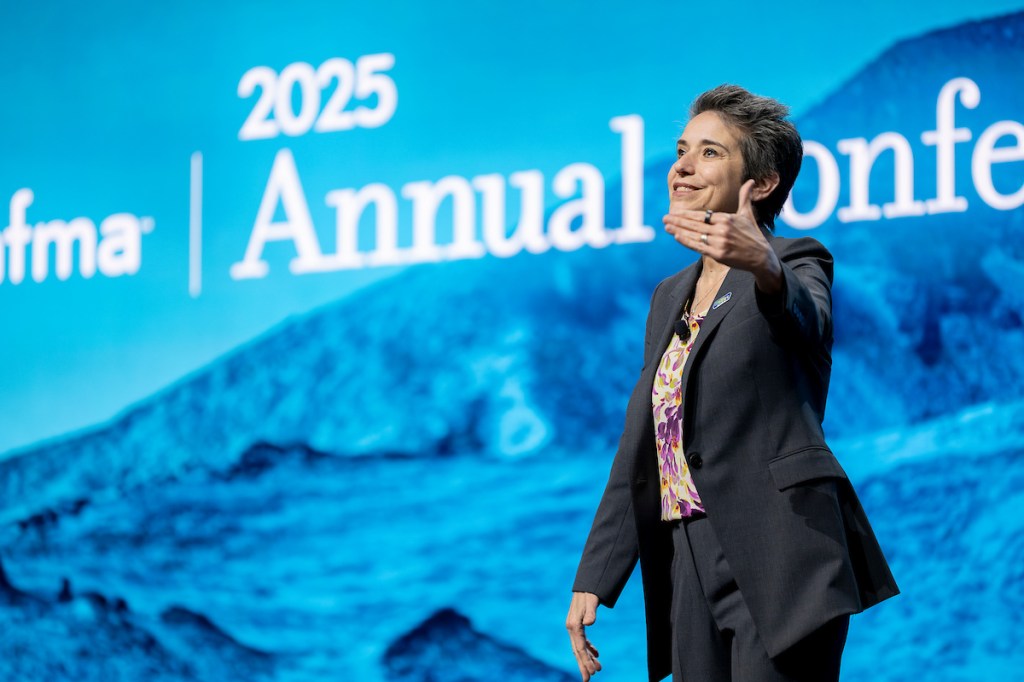Annual Conference Day 4: Expert panel discusses Medicaid and other crucial policy developments
The final day of the conference also included a leading political analyst’s take on the current state of affairs.

Hospital leaders and healthcare policy analysts are keeping a wary eye on potentially large Medicaid funding cuts that could be imminent.
As Congress decides what level of spending retrenchment to include in the budget reconciliation bill, hospital executives are left to anticipate just how big the impact will be.
For Gordon Edwards, CFO of Akron’s Children Hospital, Medicaid represents more than half of the hospital’s business.
“I kind of feel like right now it’s a 70-degree day, it’s sunny, no humidity, and life’s looking pretty good,” Edwards said. “And when I look at the horizon, I see tornadoes, thunderstorms, hail and stuff coming at me. And what I don’t know is: Is it going to be a direct hit? [Or] is it going to go a little north, is it going to go a little south? But I’m going to get hit, and to what extent, I don’t know.”
He added that from a revenue standpoint, variances in the proposals do not represent “a million [dollars] here, a million there. It’s like $30 million here, $50 million there.”
The discussion took place as part of the FastFinance Live session, exploring some of the same topics that are regularly featured in HFMA’s weekly FastFinance newsletter for healthcare executives.
More so than actual healthcare policy, the Capitol Hill conversation surrounding Medicaid “is really about going after the dollars right now,” said Rick Gundling, senior vice president with HFMA. Spending reductions are needed to help cover the costs of Republican priorities such as an extension of tax cuts.
Other rollbacks
Among other topics explored during the session, which was moderated by HFMA Senior Editor Rich Daly, was a policy push to rein in Medicare Advantage spending, especially relative to traditional Medicare.
“That’s going to be next on the list,” Gundling said. “It could have been first on the list, but it’s politically easier to address Medicaid than Medicare. But that is going to be a focus. We’re already seeing that with issues around upcoding [and] setting the base payment rates for it.”
In some states, efforts to find savings could mean implementing some form of price caps for hospital services.
Todd Nelson, director for partnerships and chief partnership executive with HFMA, pointed to employers as a driving force behind such policies.
‘Their costs are going up for healthcare, [which] increases the cost of their product or whatever they’re putting out there in the marketplace, and they’re getting fed up,” Nelson said. “So they’re pushing the state to try to create some level pricing. They can basically set the price here and the quality there to get what they need.”
Looking to regain trust
Issues of affordability also factor into public mistrust of hospitals and other healthcare entities, with discontent rising, as shown in some surveys.
“It’s hard enough many times for us [in the industry] to understand the various payment models, let alone explain that to the patient,” Nelson said. “I think we do get a black eye related to that because it is expensive and it’s complicated. So it looks like we’re always on the defensive.
“I don’t know that we have a great answer for doing that other than being out there, continuing to try to [make the case] and trying to be good stewards.”

How Trump has had a seismic impact on U.S. politics
In the closing session of the 2025 Annual Conference, Amy Walter, publisher and editor in chief of the nonpartisan Cook Political Report, provided an overview of the current political landscape and trends to watch heading into the next election cycle.
Walter said any such discussion has to start with President Donald Trump, the defining political figure of the last 10 years. In large part because of Trump, Republicans have more of a multiracial, working-class base than they once did, while the Democratic base has shifted to become more of “an elite, establishment, highly educated [coalition],” Walter said.
She said Democrats are in a weaker position than they were when Trump first took office in 2017 because their strategy of being simply the anti-Trump party can only take them so far. And younger voters, including those of color, are less responsive as a group than they once were to Democratic messaging.
Younger voters “don’t see politics in the same way that we do,” Walter said. “They don’t hear things like, ‘Democracy’s at stake,’ or ‘He’s destroying norms’ as a problem. They actually see that as a good thing. The norms for them have not been so great. They’re growing up at a time of great tumult and change.”
Polling suggests those who actively seek out news through various media tend to skew liberal, while those who are more passive in their news consumption lean conservative, Walter said. The problem for Democrats is more people fall into the latter group regarding their news habits.
The fate of pivotal legislation
The budget reconciliation bill is proving to be a heavy lift legislatively, with Republicans trying to smooth over intra-party disagreements about Medicaid funding cuts and other aspects.
Still, Walter expects the bill to pass in some form, in large part because of enthusiastic support from Trump.
“It feels to me we’re at this place where, because it’s too big to fail, because this is literally the one item that is going to make it through Congress, that this thing is going to ultimately pass and ultimately be signed by the president,” she said.
The Republican strategy seems to be to push the bill through and then use the 17 months before the midterms to fine-tune their messaging about the legislation, which has not been polling well.
The messaging likely will be, “This is not about healthcare, this is about tax cuts,” Walter said. “This is not about cutting necessary [healthcare] access for needy people, this is about making sure that those who are cheating the system are no longer able to get access to the system. Right now, Democrats are winning the argument.”
What’s on tap in 2026
Democrats also will take structural advantages into the 2026 race for the House, Walter said, noting they need to flip only three seats. Midterms tend to favor the out-of-power party because their voters are angrier and more driven.
“When it comes to elections, you really want angry people on your side,” Walter said. “Angry people vote. People who are in a pretty good place tend to either stay home, they don’t get engaged, they don’t show up and vote.”
Nonetheless, Democrats face an uphill climb in the Senate, where Republicans similarly have a three-vote advantage but only face a couple of races (Maine, North Carolina) in which their seat appears to be in any jeopardy.
Accurate prognostication is difficult, Walter said, given the recent tendency of unforeseen events to swing the course of an election. The elections of 2020 (COVID-19), 2022 (Roe v. Wade reversal) and 2024 (President Joe Biden’s withdrawal) all were impacted by such events.
“I now expect the unexpected,” Walter said. “I’m now prepared for just about anything to happen, but I’m also prepared for it to make a minor shift in the political consequences, not a major one.”
That’s a wrap
One of the final sessions of Annual Conference was a workshop in which attendees collaborated in small groups on articulating the key takeaways from the event.
Among the consensus word choices (in italics) to describe their outlook at the end of the conference, attendees said they were feeling inspired, that healthcare teams need to embrace change, challenge everything, reimagine care delivery and remove barriers to access. A gauge of success will be when trust becomes the new norm.
The event concluded with Walter’s talk, after which it was announced that the 2026 Annual Conference will take place June 7-10 in National Harbor, Md., outside Washington, D.C.





